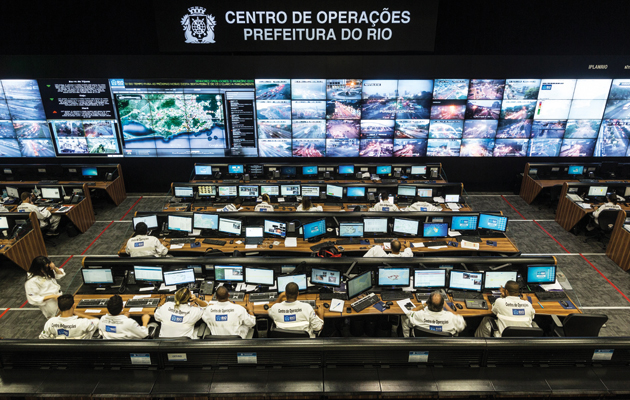|
From smart cities to mass surveillance, our December issue – out on 1 November – looks at the complex relationship between democracy and big data Rio de Janeiro’s Centre of Operations, a state-of-the-art control room designed by IBM’s Smarter Cities unit, is modelled on NASA’s Mission Control in Houston. Employees wear white jumpsuits, so they even resemble astronauts. Sitting at banks of computers, facing a wall of giant screens showing maps, video streams and data feeds, they are urban pioneers, crew members at the consoles of the intelligent city of the future. Here, all the functions of the metropolis are integrated into a single digital brain that enables Rio’s municipal leaders to offer better, more efficient services to its 6.5 million citizens. A torrent of information – a virtual portrait of the city – is analysed using computer algorithms that identify patterns and trends, and anticipate looming problems. On the basis of this number crunching, traffic can be redirected, floods anticipated, crimes prevented, and disasters averted. In the Centre of Operations, as OMA’s Reinier de Graaf notes, the city is equated with outer space, an external fact of nature rather than something man-made. Treated as such, the political system seemingly absolves itself of all responsibility and blame for its underlying problems. Response times to events such as the floods that cause landslides in the favelas are shortened, but – in a city where 25% of the inhabitants don’t formally exist – aren’t these just band-aid solutions that fail to address the root causes of these problems? In this issue we look at the complex relationship between democracy and big data. We now have the ability to survey all aspects of the physical city, but should we? Who controls that data? What protects citizens from the darker side of the connected, sentient city? And, in our quest for efficiency, won’t we lose much of the anarchy that is the lifeblood of any great metropolis? |
Words Christopher Turner
|
|
|
||
|
|
||
|
IN THIS ISSUE Smart cities Smart cities are sold as utopias, but does something sinister lurk beneath the marketing gimmick? Keiichi Matsuda The designer explores a future world of augmented (hyper) reality in a series of mesmerising films Data visualisers Graphics that bring beauty and form to raw data Design and privacy In the post-Snowden age, how can you evade mass surveillance and keep your data safe? PLUS New Gehry’s museum in Paris for Louis Vuitton, Heatherwick’s distillery in Hampshire for Bombay Sapphire, MVRDV’s Markthal in Rotterdam, Pezo Von Ellrichshausen in Catalonia, Barber & Osgerby at the V&A, and the best of the LDF and 100% Design Reviews Photographer Edwin Smith’s lost Britain, modernism in Bristol, local talent in Belgrade, Denys Lasdun and the radical politics of infrastructure In the archive Secrets of the Savoy Hotel’s card index British Design Report 24 pages of the latest British design |
||


















